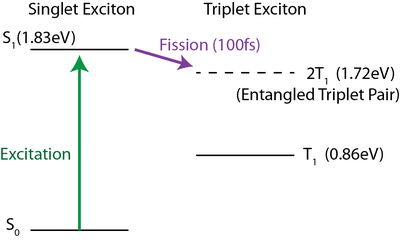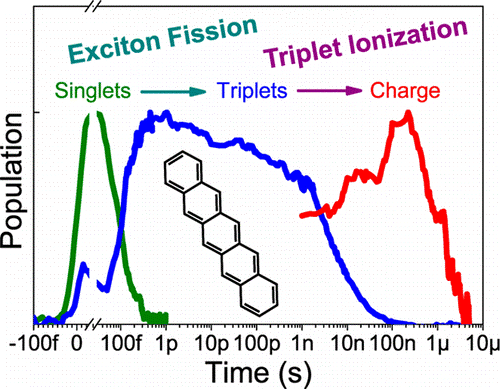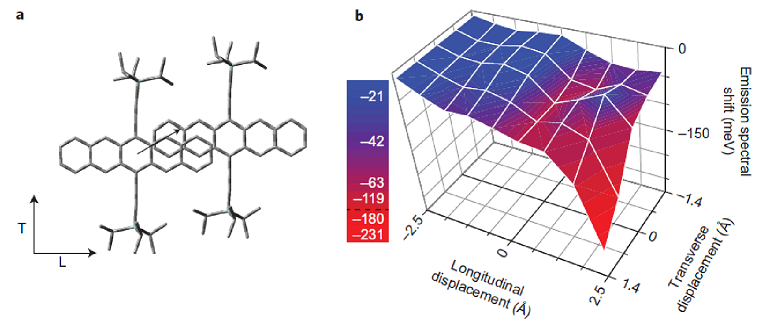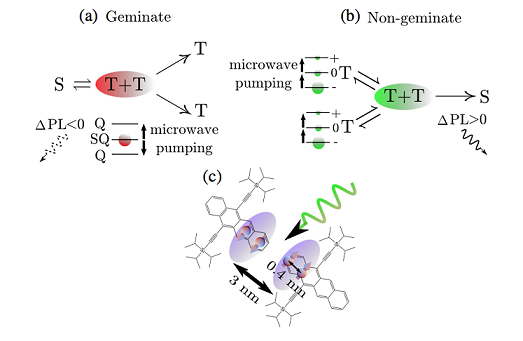Singlet Fission sensitised photovoltaic devices
Elucidating the quantum mechanical dynamics underlying the process of Singlet Exciton Fission is one of our main research goals. Understanding this process could hold the key to developing a new generation of highly efficient photovoltaics.
Singlet fission (SF) is an exciton multiplication process (fig.1) in organic semiconductors in which one photogenerated spin-singlet excited state is converted to two lower energy spin-triplet states. This triplet exciton pair is initially correlated to form an overall spin-singlet ‘multiexciton.’ This makes SF a spin-allowed process, in contrast to intersystem crossing, which involves a spin flip. For systems in which the energy of the lowest lying singlet exciton is close to twice the energy of the triplet state (e.g., pentacene and its derivatives), SF can occur on a sub-100 fs timescale with every singlet converted to two triplets. SF may thereby enable photovoltaic devices to overcome thermalisation losses, potentially allowing single-junction devices that could beat the Shockley-Queisser limit on power conversion efficiency.

Figure 1: Singlet Exciton Fission in a molecular semiconductor
The singlet to triplet conversion in SF typically takes place on the timescales from 80fs to 100ps, which requires ultrafast optical techniques to resolve the electronic and molecular dynamics in time. In our group we use a variety of spectroscopic methods including photoluminescence, pump probe, and photon echo techniques to understand and control the main parameters behind SF dynamics in both films and devices.
Examples of Singlet Fission projects
- We use ultrafast transient absorption spectroscopy with sub-20 fs time resolution and broad spectral coverage to resolve in time the process of exciton fission in organic polycrystalline thin films. For example, for pentacene we observed that the initially photogenerated singlet excitons evolve into triplet excitons on an ∼80 fs time scale (fig.2). This implies that exciton fission occurs at a rate comparable to phonon-mediated exciton localization processes and may proceed directly from the initial delocalized state. We have also demonstrated that the fission-generated triplets can be efficiently converted to charges at the interface between a fission sensitizer and a fullerene or nanocrystal film.

Figure 2: The dynamics of singlet fission followed by the conversion of triplets to charge pairs as observed by transient absorption spectroscopy.
[1]. Wilson M.W.B., Rao A., Ehrler B., Friend R.H., Singlet Exciton Fission in Polycrystalline Pentacene: From Photophysics toward Devices, Acc. Chem. Res. 46, 1330 (2013)
- As a model system for understanding SF and it sensitivity to molecular ordering and electronic coupling, we investigate the SF process in concentrated solutions of organic semiconductors. In solutions of bis(triisopropylsilylethynyl (TIPS)) pentacene, we observed a triplet yield of 200% and triplet formation rates approaching the diffusion limit. We also observed a transient bound excimer intermediate, formed by the collision of photoexcited and ground-state TIPS-pentacene molecules. This intermediate breaks up when the two triplets separate to each TIPS-pentacene molecule.

Figure 3: (a) Starting geometry for the TIPS-pentacene excimer from the solid-state crystal structure. Transverse (T) and longitudinal (L) axes are indicated. (b) Effect of p-stacking on the emission spectral red-shift between the excimer and monomer structures.
[2]. Walker B.J., Musser A.J., Beljonne D., Friend R.H., Singlet exciton fission in solution, Nature Chemistry 5, 1019 (2013)
-
Recent studies use combined optical and electron spin resonance techniques to investigate the nature of triplet states formed by singlet fission. Through the use of optically detected magnetic resonance (ODMR) we have distinguished between geminate and non-geminate triplet interactions in solution-processable singlet-fission materials[3]. This technique was used further to determine the strength of interaction and spatial extent of the triplet excitons formed through SF (fig. 4).

Figure 4: Effect of microwave pumping on the triplet pair states in the (a) geminate and (b) non-geminate cases. (c) Spatial distribution of triplet-pair states formed by singlet fission.
[3]. Bayliss S.L., Chepelianskii A.D., Sepe A.,Walker B.J., Ehrler B., Bruzek, M.J., Anthony J.E., and Greenham N.C., Geminate and Nongeminate Recombination of Triplet Excitons Formed by Singlet Fission, Phys. Rev. Lett. 112, 23 (2014)
